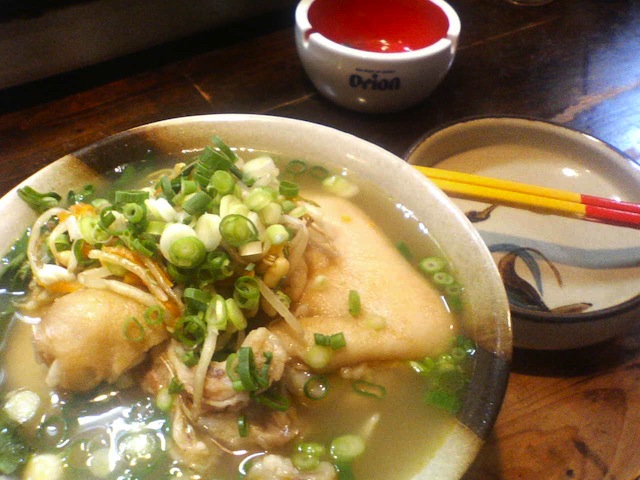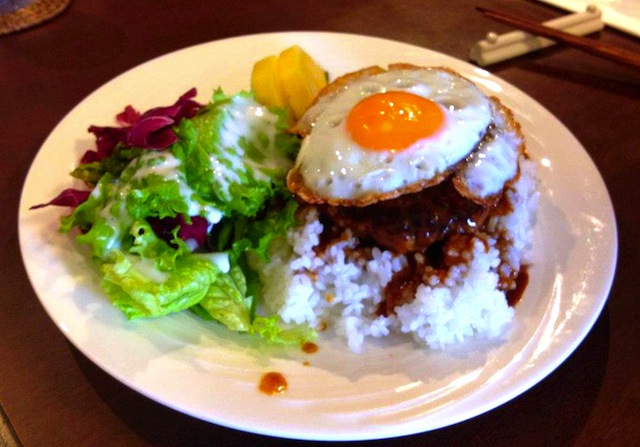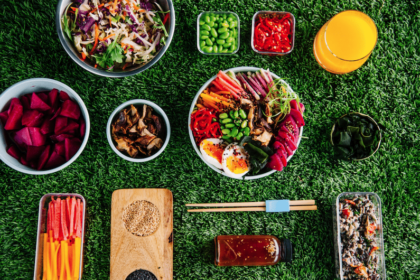
While many people think of Japanese cuisine as being one large group of dishes, the ingredients used and meals eaten often vary by region. The Okinawa Prefecture is Japan‘s southernmost prefecture, composed of hundreds of islands and showcasing a culture, climate and cuisine different from the mainland. For example, while mainland Japan had a large Buddhist population until the mid-19th century they did not eat pork and goat meat, which has always been popular in Okinawa since their religion is traditionally shamanistic.
Because of trade China and Southeast Asia influenced the diet, which can be seen in popular ingredients like the Okinawan sweet potato, goya (bitter melon) and nabera (towel gourd). Moreover, chefs from Okinawa who traveled to mainland Japan to study brought back with them ingredients, recipes and knowledge.
It’s worth noting people from Okinawa tend to live very long, healthy lives — longer than any other population in the world. In fact, it’s not uncommon for locals to live past 100 years of age. Moreover, many elderly Okinawans age without having to deal with illness or disease. If visiting, don’t be surprised to see 90-year-olds out riding bicycles, dancing, sweeping the streets and fully taking care of themselves. Much of this is attributed to their diet of locally-sourced ingredients and dishes that are low in calories and incorporate an array of fruits and vegetables. To help give you a visual taste of some of Okinawa’s typical cuisine, here are some of our favorite local dishes:
Taco Rice
This iconic dish was inspired by the Mexican tacos introduced by the American military. There is an ongoing debate about what year it was created — 1960 or 1980 — although believers of 1980 have a bit of evidence, as they believe the dish was created by a chef in a restaurant called Parlor Senni in Kin, Okinawa. This would make sense as the eatery is located close to the entrance of Camp Hansen, a US Marine Corps base. Because the people of Okinawa didn’t love the taco shells, they used their staple of rice and kept the beef, lettuce, tomato and seasoning.

Hirayachi
This pancake-like dish consists of eggs, flour, salt, black pepper and green onions, fried with a little oil in a pan. The snack is popular in Okinawa due to the fact it’s easy to make and the ingredients are typically ones people always have in their home, which is helpful when typhoons hit. Fun fact: The name of this dish comes from the Okinawan word “hirayaki,” which means “flatly fried.”
Kimchi
While originally from Korea, Kimchi is also eaten on the islands of Okinawa. The dish is based on fermented Korean pickle and cabbage, and from there can contain whatever meats, vegetables and additions you’d like. For example, the above bowl has pork and egg. Not only is this dish tasty, it’s also extremely healthy, with a large dose of vitamins A, B, and C and healthy bacteria to aid in digestion.
Ikasumi Shiru
This rich yet light dish features cuttlefish and pork in a bonito-based broth with cuttlefish ink. The ink is somewhat creamy with flavors of fish and salt, while the pork adds meaty taste.

Rafute
Rafute refers to pork ribs simmered for hours in fish broth and awamori, a Thai rice and rice malt liquor. The simmering removes the raw pork-flavor, as well as much of the fat. You’ll often find this meat on top of soba noodles or as a side-dish to tofu champuru.

Champuru Dishes
Champuru refers to Okinawa’s “mixed together” dishes. The most common champuru dish is Goya Champuru, a blend of vitamin and mineral-rich bitter melon (goya), egg, tofu, vegetables and either Spam or thinly-sliced pork. You should also try Tofu Champuru, a stir-fry dish containing vegetables, tofu and some kind of meat like pork belly, tuna, bacon or Spam. The tofu found in Okinawa has a firmer texture than that on mainland Japan. Fu Champuru is a dish made with fu — a bran, water and egg flatbread — stir-fried with vegetables and meat. Moreover, Somen Chanpuru consists of very thin noodles stir-fried with green onions and meat.

Okinawan Soba
Made from 100% white flour, it is typical served in a bowl of broth with bonito, fish paste, spices and pork with thick slices of spareribs (soki) or three-layered pork (sanmainiku).

Tebichi
This dish consists of boiled pig’s feet simmered for hours on low heat. Tebichi is a delicacy specific to Okinawa and has a soft chewy texture. Many times, it’s served in a soup with noodles and vegetables. You’re probably wondering how a pork-based food can be part of a healthy diet. Locals attest this dish is full of collagen, which keeps their joints and skin lubricated.
Beef Curry
Okinawa is probably not the first place you think of when imagining a spicy dish of beef curry; however, it is plentiful in the region as well as on the mainland. The sweet and tangy beef is placed on top of a bed of Okinawa’s signature creamy rice. You can also find bitter melon (goya) curry in Okinawa.
Loco Moco
One of the most fun to say dish names in Okinawa, the meal consists of a beef patty topped with a fried egg and brown gravy and served on a bed of rice. It’s also served with a side of local salad.
Umi-budō
Also known as sea grapes or green caviar, umi-budō is a seaweed that grows plentifully in Okinawa as well as the Philippines. Typically, it is eaten raw with vinegar either as a snack or in a salad. The beads are soft and plump and, like traditional caviar, pop in your mouth to release their full salty flavor.

Mochi
Mochi is a Japanese rice cake made of sticky rice that is pounded into paste and molded into the desired shape. Many types of wagashi, or Japanese confectionery, are made using mochi. A typical dessert is Oshiruko, a sweet soup with red azuki beans and mochi balls.
Chinsuko
A traditional Okinawan cookie, it tastes similar to a Lorna Doone and contains flour, lard and sugar. Many local ice cream shops also serve it as a flavor.
Sashimi
While many people know of sashimi — thin slices of fresh raw fish like tuna and salmon — in Okinawa you may find it served on top of a bed of rice and with a poached egg, such as at the HOSHINOYA Nirakanai Resort on Iriomote Island.
Saataa Andagii
This typical Okinawan doughnut is made of flour, sugar and eggs and resembles tulips.

Orion Beer
‘For Your Happy Time’ the ‘Beer of Beers’
Orion Brewery is the fifth-largest brewery in Japan, and is located in Urasoe, Okinawa Prefecture. The brewery uses local water as well as German Hallertaurer hops and European and Australian malts to craft their beers. While it only represents 1% of the beer market in Japan, it accounts for 50% of the market in Okinawa. The brew is described crisp, refreshing, mild and full-flavored.

Awamori
Made from rice and rice malt, this indigenous libation is Japan’s oldest distilled liquor. Typically 60 to 86 proof, awamori is aged to improve its flavor. Although sometimes used in cocktails, awamori is typically served with water and ice.
Jessica Festa
Latest posts by Jessica Festa (see all)
- A Culturally-Immersive Adventure In Mongolia’s Altai Mountains - Jul 8, 2023
- This Recipe Sharing Platform Supports Women In The Culinary Industry (Labneh Recipe Included!) - Nov 5, 2020
- Hiking The Mohare Danda Community Eco-Trek In Nepal - Jun 3, 2020
- 6 Important Questions For Choosing A Responsible Yoga Retreat - May 18, 2020
- How To Create & Grow A Profitable Blogging Business (Ethically) - Jan 18, 2020














Except for mochi and sashimi, there aren’t a lot of these menu items in restaurants in California. Would love to explore these more. Will definitely have to take a look at these when I travel to Okinawa.